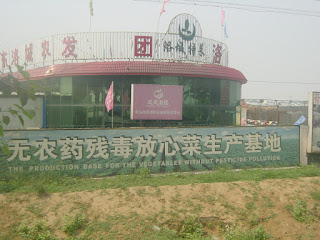At a press conference held in conjunction with the National Peoples Congress, Minister of Agriculture Han Changfu was asked what officials are doing to address the Chinese public's concerns about residues of pesticides and veterinary drugs in food. Minister Han noted that the issue of pesticide residues in food comes up at these press conferences each year. He emphasized that China is moving in the right direction but he acknowledged that toxic residues in food remain a prominent problem.
Minister Han said that 39 highly toxic pesticides had been banned in the last few years, and 12 had been restricted to nonfood crops. There are plans to ban three more toxic pesticides. He claimed the proportion of highly toxic pesticides had fallen from 35 percent in the 1990s to 3 percent now. The Minister said more effort will be made to test vegetables for pesticide residues, to monitor the pesticide industry, and to limit entry to the industry. Great idea! But it has taken 35 years so far to deal with this problem.
Long-forgotten "Number 1 Documents" on rural policy issued by communist party leaders during the 1980s had already recognized toxic pesticides as a serious problem:
- The first "Number 1 document" issued in 1982: "Put more effort into producing efficient, low toxicity pesticides, struggle to eliminate highly-toxic pesticides."
- The 1983 "Number 1 document" contained similar language: "...eliminate highly toxic, low-efficiency pesticides as soon as possible."
Mention of pesticides disappeared from "Number 1 documents" in 1984-86. The problem persisted, and measures were taken to deal with it. In the early 1990s, a "Green Food" certification was introduced to quell concerns of trade partners that Chinese food exports were tainted with pesticides and pollutants. Japanese companies procuring vegetables and fruits from China during the 1990s introduced measures to control use of pesticides. In 2001, the Ministry of Agriculture launched an action plan for "nonpolluted food" (无公害, which translates directly as "without public harm"), featuring certifications that production areas were free of toxic pesticides and pollutants and a network of testing centers intended to ease domestic consumers' concerns about pesticide residues.
Farm for producing "vegetables without toxic pesticide residues" in 2006,
in the vicinity of the farms caught growing ginger with toxic pesticides in 2013.
The document issued in 2004 focused on how to boost rural incomes and contained no mention of pesticides. But toxic pesticides and measures to deal with the problem appeared in all but three Number 1 Documents from 2005 to 2017.
- 2005: "ban the production, sale and use of highly toxic, high-residue pesticides."
- 2006: nothing
- 2007: "Actively develop new-type fertilizer and low-toxicity, high-efficiency pesticides"
- 2008: "Accelerate research and development on high-efficiency, safe pesticides"
- 2009: "Launch special rectifications; resolve to stop illegal use of pesticides and veterinary drugs."
- 2010-11: nothing
- 2012-16: each document advocated promotion of low-toxicity, efficient pesticides.
In 2016, China's Ministry of Agriculture launched a campaign to achieve zero-growth in pesticide and fertilizer use by 2020. This objective was included in the 2016 and 2017 Number 1 documents.
- 2017: "Establish a complete chemical fertilizer and pesticide industry production supervision and product traceability system: place strict limits on entry to the industry."
Lab in Jiangsu Province for testing fish for veterinary drug residues in 2007. Spotless! Unused, maybe?
At the same press conference this month, the Minister promised to crack down on use of clenbuterol in livestock production. Authorities in China banned this substance 17 years ago, and clenbuterol was specifically targeted in the 2007 food safety action plan. Ten years ago the Ministry claimed that its testing had detected no clenbuterol for three years in a row. Yet, in 2011 a clenbuterol scandal implicated what is now the world's largest pork company. The following year, 2012, the Number 1 Document called for "Strict control of feed additives." This month, the Minister also singled out for rectification the use of two veterinary drugs--malachite green and nitrofurans--used in fish-farming. These were specifically targeted in the 2007 action plan. The objective of the State Council's food safety action plan a decade ago was stated as follows:
"By the end of 2007...the problems caused by the use of unlawful and banned pesticides, veterinary pharmaceuticals, and feed additives should basically be resolved."While we're at it, we will point out that 1980s-era documents raised other concerns that have since risen to crisis levels: declining soil fertility, excessive chemical fertilizer use, and disappearance of organic matter from soils. These are also major problems the current generation of agricultural officials in China is trying address after years of neglect. The directive in the 1986 Number 1 Document,
"We must make efforts to raise the productive capacity of land...by reversing the neglect of organic fertilizer and increasing organic matter in soils,"is identical to mantras recited by China's agricultural officials today.
Minister Han is probably sincere about his resolve to eliminate toxic pesticides, as were leaders a generation ago who wrote the 1982 document. But the decades-long saga of Chinese pesticides shows that what government leaders say or do often has little bearing on what actually occurs on the ground. Problems can build up for years before decrees from Beijing filter down to the grass roots. Problems have to build up to crisis levels before local officials fall in line behind their central government comrades to take part in the dragon dance.





No comments:
Post a Comment